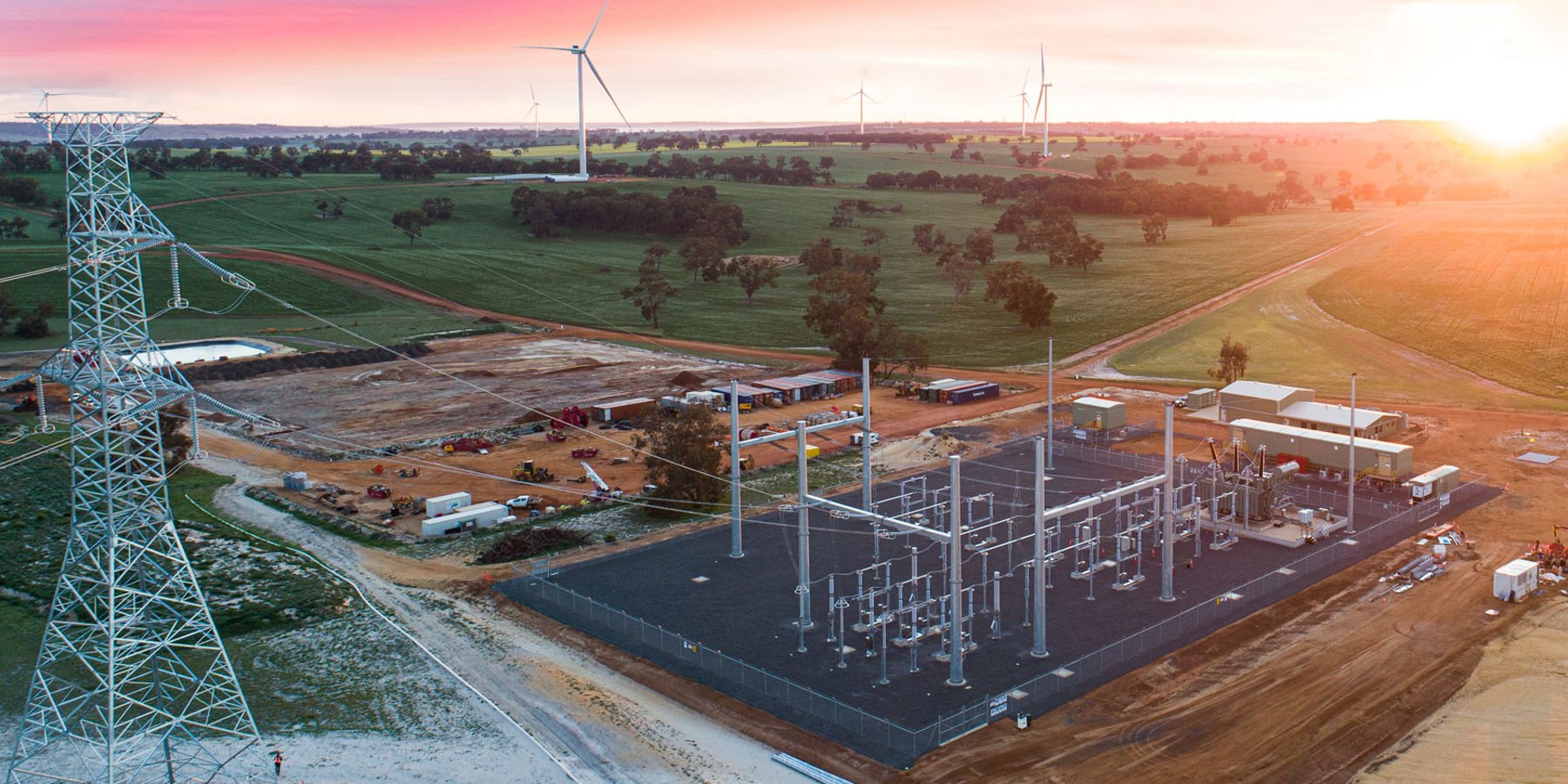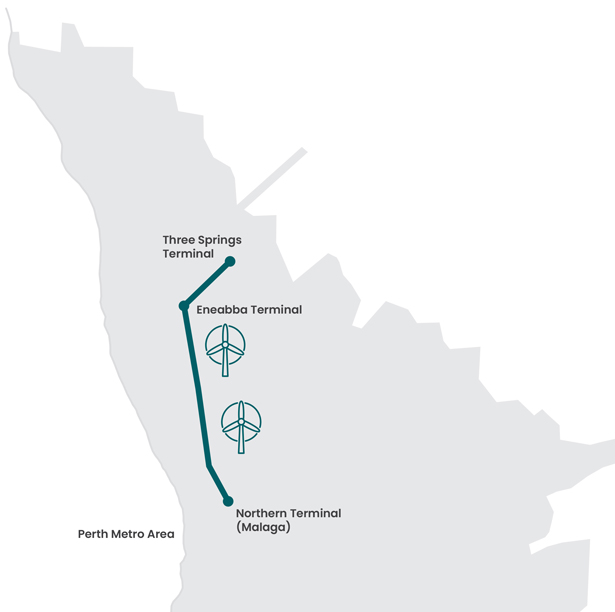
Clean Energy Link – North Region transmission upgrades
With wind and solar that are the envy of the world, WA and the Mid West region in particular, has the capacity to propel WA to become a national and international leader in green energy solutions.

With access to world class natural resources, the Mid West region is one of the best locations to harness the power of wind and solar energy. Home to two wind farms including one of the State’s largest, this established generation hub has the capacity to serve as a significant source of clean energy for the SWIS, and power WA towards net zero by 2050.
A critical first step in achieving this is strengthening the existing network to ensure it can connect and transport a greater supply of renewable energy to meet decarbonisation objectives. Modelling shows a 10 x increase in generation is needed.
This will involve upgrading the current mix of 132 kV and 330 kV lines in parts of the northern network to unlock the transmission capacity in the Wheatbelt and Mid-West.
The State Government has invested a total of $655 million for Western Power to scope and build new transmission infrastructure and undertake reinforcement work, leveraging existing network infrastructure, corridors and easements where possible to minimise possible impacts on the communities.
Work includes:
- New 330 kV and 132 kV transmission line and terminal builds within in the existing network footprint to significantly increase transmission capacity and enable new energy sources to come online.
- Existing line conversions and reinforcement work to significantly improve the flow of renewable energy to and from the area.
The benefits from this work are unparalleled enabling emissions reduction of around 2.4 million tonnes of CO2 as well as significant jobs and economic growth for our regional communities.
Benefits to industry and community
By strengthening and building on the existing network, more of the clean energy generated from existing wind farms can be used.
It also paves the way for several renewable generation projects currently in the pipeline to progress, increasing the flow of green electrons from the Mid West region and onto the electricity grid.
How is this work being funded?
The State Government is investing a total of $655 million for Western Power to scope, plan and construct new transmission infrastructure to strengthen the northern network, leveraging existing network infrastructure, corridors and easements where possible to minimise possible impacts on the communities.
This includes the initial $60 million for the purchase of long lead items and $20 million for scoping and planning work.
When will the work start?
Early planning and scoping, and feasibility studies have started to enable network planning, land access and concept designs as well as the work on procuring long-lead items.
Our scoping work involves undertaking a combination of the following activities:
- consultation with local governments and State Government agencies
- extensive engagement with private landowners and community
- environmental impact assessments
- cultural heritage assessments
The construction target date is 2027.
FAQs
Western Australia’s Mid-West region has an abundance of wind and solar and the State Government is committed to ensuring these renewable energy resources are harnessed to achieve its decarbonisation goals. Home to two wind farms, and with above average number of sunny days per year, this region has the potential to serve as a significant source of clean energy for the South West Interconnected System (SWIS), and power WA towards net zero emissions by 2050.
To unlock the capacity of the network’s northern region and transport greater amounts of renewable energy, we need to upgrade parts of the existing 132 kV and 330 kV transmission network.
This is a critical first step to ensuring the network can connect and transport a greater supply of clean energy to meet future energy demand.
Network strengthening will involve augmenting transmission infrastructure and undertaking essential reinforcement work, leveraging existing network infrastructure, corridors, and easements where possible to minimise impacts on communities and cultural, social, and environmental values.
State Government funding of $575 million has been provided to increase capacity and enable new renewable energy to come online by:
- Potential new 330 kV double circuit transmission line following current transmission lines located within existing easements, from Northern Terminal in Malaga to Neerabup Terminal (substation) in Pinjar.
- Potential new single circuit 132 kV transmission line between Padbury and Wangara Substations, supported by proposed new 330 kV transmission lines and upgrades to terminals and substations.
- Potential new double circuit 132 kV transmission line between the Wangara Substation and Neerabup Terminal to improve the flow of renewable energy to and from the north region. This will be supported by proposed new 132 kV transmission lines and upgrades to terminals and substations.
- Potential new line to T-off from existing network infrastructure on a 132 kV line between Northern Terminal and Northam to connect Henley Brook Substation. The new line will be supported by new 132 kV transmission lines and upgrades to terminals and substations.
- Potential 132kV to 330kV line conversion between Northern Terminal and Three Springs Terminal to improve the flow of renewable energy to and from the area. This will be supported by new 132kV terminals at Three Springs Terminal and Eneabba Terminal and a new 330kV terminal within in the vicinity of the existing Regans Substation.
The State Government is investing $655 million for Western Power to scope, plan and construct new transmission infrastructure to strengthen the existing northern network.
This includes the initial $60 million for the purchase of long lead items and $20 million for scoping and planning work.
Early planning and scoping, and feasibility studies are underway to facilitate network planning, land access and concept designs; as well as procuring long-lead items.
The timeline for each program of work will vary depending on results of relevant scoping surveys and assessments, community engagement and final line route designs.
The construction target date is 2027. Indicative timelines can be found on our website.
To identify a potential route for a transmission line, we begin by identifying start and end points, which usually are a terminal or substation.
We then define a suitable area to further scope, taking into consideration existing transmission lines and Western Power easements, where possible to minimise impacts.
We work with landowners, communities, environmental groups and other key stakeholders to better understand local considerations.
This includes carrying out rigorous environmental and cultural heritage assessments.
At a minimum, we consider the following:
- Environmental factors
Robust and thorough environmental assessments are essential in assessing any potential work. This includes flora and fauna surveys to ensure we meet State and Federal Government requirements. - Social, heritage and planning factors
We seek input from relevant planning departments, including local government. We undertake cultural heritage surveys to consider Aboriginal cultural heritage values. - Economic factors
As a Government Trading Enterprise we must always undertake a cost benefits analysis to ensure we are serving the best interests of the community.
We factor this in from planning solutions, efficient design to construction and ongoing maintenance and access.
For some of the potential line routes for the northern expansion, we have begun proactively consulting local governments, and engaging local communities through targeted direct communications and on-site and drop-in community sessions.
We will continue to keep communities updated via our website on future engagement opportunities and the outcomes of cultural heritage and environmental impact assessments.
The potential new transmission lines will be overhead, which is consistent with the existing transmission infrastructure and enables it to be built at the most efficient cost.
Undergrounding transmission lines can be costly.
The community and industry want more renewable energy to reduce their carbon footprint and the network needs to facilitate this by connecting greater renewable energy generation.
Forecasted energy demand points to a significant expansion of our transmission network. To meet the anticipated new load, a significant number of renewable generators will need to connect to our network.
We provided input to the State Government’s SWIS Demand Assessment (SWISDA), which was released in May 2023 and modelled the potential increased demand for low-emissions electricity on the grid.
Significant consultation with major electricity users from a wide variety of existing and new industry sectors was undertaken as part of SWISDA. This included mining, minerals and metals processing and hydrogen, as well as renewable energy project developers.
The SWISDA report suggested that around 50 gigawatts of renewable energy and storage would be required to support the increased electricity demand and that around 4,000km of new transmission infrastructure would be required to transport that electricity from where it is generated, to where it is used.
Keeping the lights on is fundamental to our business - the community is our primary beneficiary.
Investments in the transmission network will improve system reliability.
They are complemented by our investment in the distribution network to improve location specific reliability performance.
We’re continuing to use and deploy new technologies to ensure the most cost-effective solution that maintains (and in many cases improves) the safety and reliability of our service.
We continue to deploy Stand-alone Power Systems and microgrids in regional areas. In higher density areas, we are undergrounding our ageing overhead network.
Improving reliability continues to be a priority and in the past year we completed the significant work required to address this.